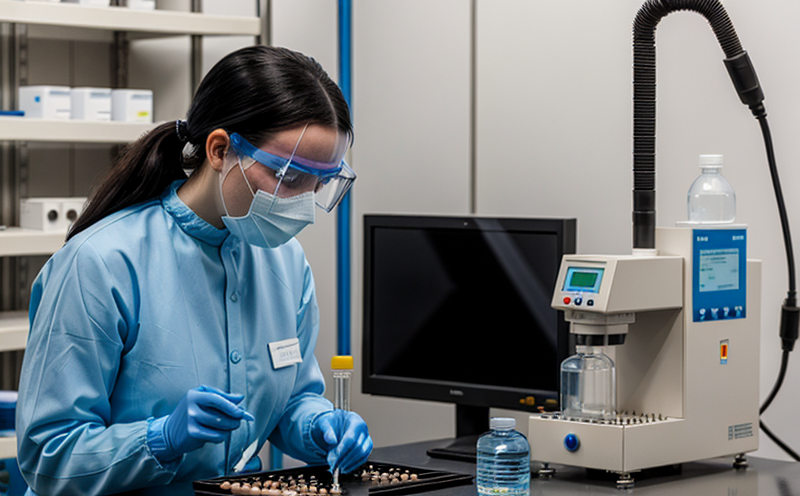AOAC Pesticide Residue Profiling Testing
The AOAC (Association of Official Analytical Chemists) pesticide residue profiling testing is a critical service in pharmaceutical quality assurance and compliance. This method ensures that the active ingredients, excipients, and final products meet stringent international standards for safety and efficacy. The primary purpose is to identify and quantify pesticides and their metabolites present in agricultural products used as raw materials or intermediates in drug manufacturing.
The testing procedure involves a series of steps aimed at providing comprehensive pesticide residue profiles that are compliant with relevant regulatory guidelines such as ISO, ASTM, EN, and IEC standards. The service targets quality managers, compliance officers, R&D engineers, and procurement teams who need to ensure the purity and safety of their supply chain.
The AOAC method uses advanced chromatographic techniques like Liquid Chromatography-Mass Spectrometry (LC-MS) and Gas Chromatography-Mass Spectrometry (GC-MS). These instruments are capable of detecting minute quantities of pesticides, making them highly sensitive and accurate. The process begins with the extraction of residues from the samples using solvents or other methods suitable for the type of matrix involved.
The extracted compounds are then purified and concentrated if necessary before being introduced into the chromatographic system. The separation efficiency allows for precise identification and quantification of each pesticide present in the sample. This comprehensive approach ensures that no residue goes undetected, which is essential given the stringent regulatory requirements governing pesticide use in pharmaceuticals.
Once the separation process is complete, the compounds are introduced into the mass spectrometer where they undergo ionization followed by fragmentation analysis. The resulting spectra provide detailed information about each compound's molecular structure and allow for positive identification based on unique retention times and fragment ions.
The AOAC method also includes a stringent quality control protocol that involves replicate samples and matrix-matched calibrants to ensure reproducibility and accuracy of results across different batches or laboratories. This ensures consistency in reporting, which is crucial when dealing with international standards.
Upon completion of the analysis, detailed reports are generated containing all relevant data including retention times, peak areas, and calculated concentrations for each pesticide detected. These reports serve as critical documentation supporting regulatory submissions and internal quality control processes within pharmaceutical manufacturing facilities.
Why It Matters
The importance of AOAC pesticide residue profiling testing cannot be overstated in the pharmaceutical sector. Ensuring that agricultural products used as raw materials or intermediates do not contain harmful levels of pesticides is paramount to maintaining product safety and efficacy. Regulatory authorities worldwide have stringent guidelines regarding pesticide residues, and non-compliance can lead to severe consequences including product recalls, legal action, and reputational damage.
By employing AOAC methods, pharmaceutical companies demonstrate their commitment to quality and adherence to international standards. This not only helps in maintaining compliance but also enhances trust among consumers who value safe and reliable medications. Additionally, the use of these advanced analytical techniques contributes significantly towards sustainability initiatives by promoting responsible agricultural practices that minimize environmental impact.
The AOAC method ensures that even trace amounts of pesticides are detected, thereby preventing potentially harmful substances from reaching end users. This proactive approach helps protect public health while fostering a safer environment for all stakeholders involved in drug manufacturing and distribution.
Environmental and Sustainability Contributions
The AOAC pesticide residue profiling testing plays an integral role in environmental protection and sustainability efforts within the pharmaceutical industry. By ensuring that raw materials are free from excessive pesticide residues, this service helps reduce contamination risks both during manufacturing processes and throughout supply chains.
Minimizing pesticide exposure not only protects human health but also supports biodiversity conservation by preserving natural ecosystems from harmful chemicals. Furthermore, adhering to strict quality control measures through AOAC methods encourages sustainable agricultural practices among suppliers, leading to more efficient resource utilization and lower environmental footprints.
The precision offered by advanced chromatographic techniques used in AOAC testing allows for accurate quantification of pesticide levels down to parts per billion (ppb) or even parts per trillion (ppt). This level of sensitivity ensures that only necessary amounts are present, minimizing unnecessary chemical loading on the environment. Moreover, regular monitoring and reporting based on these tests contribute valuable data towards understanding trends in agricultural practices and their impacts.
By integrating AOAC pesticide residue profiling into routine quality assurance protocols, pharmaceutical companies can take proactive steps towards reducing their ecological footprint while continuing to produce high-quality medicines that meet global standards for safety and effectiveness. This commitment aligns with broader sustainability goals aimed at creating healthier communities and preserving natural resources for future generations.





